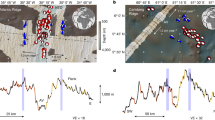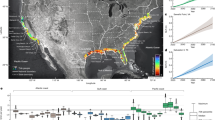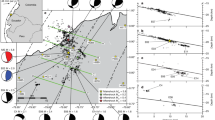Abstract
Initially, the devastating Mw 7.0, 12 January 2010 Haiti earthquake seemed to involve straightforward accommodation of oblique relative motion between the Caribbean and North American plates along the Enriquillo–Plantain Garden fault zone. Here, we combine seismological observations, geologic field data and space geodetic measurements to show that, instead, the rupture process may have involved slip on multiple faults. Primary surface deformation was driven by rupture on blind thrust faults with only minor, deep, lateral slip along or near the main Enriquillo–Plantain Garden fault zone; thus the event only partially relieved centuries of accumulated left-lateral strain on a small part of the plate-boundary system. Together with the predominance of shallow off-fault thrusting, the lack of surface deformation implies that remaining shallow shear strain will be released in future surface-rupturing earthquakes on the Enriquillo–Plantain Garden fault zone, as occurred in inferred Holocene and probable historic events. We suggest that the geological signature of this earthquake—broad warping and coastal deformation rather than surface rupture along the main fault zone—will not be easily recognized by standard palaeoseismic studies. We conclude that similarly complex earthquakes in tectonic environments that accommodate both translation and convergence—such as the San Andreas fault through the Transverse Ranges of California—may be missing from the prehistoric earthquake record.
This is a preview of subscription content, access via your institution
Access options
Subscribe to this journal
Receive 12 print issues and online access
$259.00 per year
only $21.58 per issue
Buy this article
- Purchase on Springer Link
- Instant access to full article PDF
Prices may be subject to local taxes which are calculated during checkout




Similar content being viewed by others
References
Cavallo, E., Powell, A. & Becerra, O. Estimating the Direct Economic Damage of the Earthquake in Haiti (RES Working Papers 4652, Inter-American Development Bank, Research Department, 2010).
Dixon, T. et al. Relative motion between the Caribbean and North American plates and related boundary zone deformation based on a decade of GPS observations. J. Geophys. Res. 103, 15157–15182 (1998).
Manaker, D. M. et al. Interseismic plate coupling and strain partitioning in the Northeastern Caribbean. Geophys. J. Int. 174, 889–903 (2008).
Mann, P. et al. 18th Caribbean Geological Conference, March 24–28, 2008, Santo Domingohttp://www.ig.utexas.edu/jsg/18_cgg/Mann3.htm.
Mann, P., Matumoto, T. & Burke, K. Neotectonics of Hispaniola—plate motion, sedimentation, and seismicity at a restraining bend. Earth Planet. Sci. Lett. 70, 311–324 (1984).
Frohlich, C. & Apperson, K. D. Earthquake focal mechanisms, moment tensors, and the consistency of seismic activity near plate boundaries. Tectonics 11, 279–296 (1992).
Prentice, C. S. et al. Seismic hazard of the Enriquillo Plantain Garden fault in Haiti inferred from palaeoseismology. Nature Geosci. 10.1038/ngeo991 (in the press).
Nettles, M. & Hjörleifsdóttir, V. Earthquake source parameters for the January 12 Haiti main shock and aftershock sequence. Geophys. J. Int. 183, 375–380 (2010).
Taylor, F. W., Frohlich, C., Lecolle, J. & Strecker, M. Analysis of partially emerged coals and reef terraces in the central Vanuatu arc: Comparison of contemporary coseismic and nonseismic with quaternary vertical movements. J. Geophys. Res. 92, 4905–4933 (1987).
Briggs, R. W. et al. Deformation and slip along the Sunda megathrust in the great 2005 Nias–Simeulue earthquake. Science 311, 1897–1901 (2006).
Calais, E. et al. Transpressional rupture of an unmapped fault during the 2010 Haiti earthquake. Nature Geosci. 10.1038/ngeo992 (in the press).
Puebellier, M., Mauffret, A., Leroy, S., Vlia, J. M. & Amilcar, H. Plate boundary readjustment in oblique convergence: Example of the Neogene of Hispaniola, Greater Antilles. Tectonics 19, 630–648 (2000).
Florensov, N. A. & Solonenko, V. P. (eds) The Gobi-Altai Earthquake (Akademiya Nauk USSR, 1963) [in Russian] (English translation, US Department of Commerce, 1965).
Pacheco, J. F., Estabrook, C. H., Simpson, D. W. & Nábêlek, J.L. Teleseismic body wave analysis of the 1988 Armenian earthquake. Geophys. Res. Lett. 16, 1425–1428 (1989).
Hanks, T. C. & Krawinkler, H. The 1989 Loma Prieta earthquake and its effects: Introduction to the special issue. Bull. Seismol. Soc. Am. 81, 1415–1423 (1991).
Berberian, M. et al. The 1997 May 10 Zirkuh (Qa’enat) earthquake (Mw 7.2): Faulting along the Sistan suture zone of eastern Iran. Geophys. Res. Lett. 136, 671–694 (1999).
Aagaard, B. T., Anderson, G. & Hudnut, K. W. Dynamic rupture modeling of the transition from thrust to strike-slip motion in the 2002 Denali fault earthquake, Alaska. Bull. Seismol. Soc. Am. 94, S190–S201 (2004).
Talebian, M. et al. The 2003 Bam (Iran) earthquake: Rupture of a blind strike-slip fault. Geophys. Res. Lett. 31, L11611 (2004).
Liu-Zeng, J. et al. Co-seismic ruptures of the 12 May 2008, Ms 8.0 Wenchuan earthquake, Sichuan: East–west crustal shortening on oblique, parallel thrusts along the eastern edge of Tibet. Earth Planet. Sci. Lett. 286, 355–270 (2009).
Bayarsayhan, C. et al. 1957 Gobi-Altay, Mongolia, earthquake as a prototype for southern California’s most devastating earthquake. Geology 24, 579–582 (1996).
Heaton, T. H. Evidence for and implications of self-healing pulses of slip in earthquake rupture. Phys. Earth Planet. Inter. 64, 1–20 (1990).
Ji, C., Helmberger, D. V. & Wald, D. J. A teleseismic study of the 2002, Denali, Alaska, earthquake and implications for rapid strong motion estimation. Earthq. Spectra 20, 617–637 (2004).
Wessel, P. & Smith, W. H. F. New, improved version of Generic Mapping Tools released. EOS Trans. AGU 79, 579 (1998).
Acknowledgements
We thank V. Tsai, H. Benz, J. McCarthy, R. Bilham and three anonymous reviewers for their comments in improving this manuscript. The study benefited greatly from the assistance of P. Jean of Le Bureau des Mines et de l’Energie d’Haiti, and from the logistical aid of R. Boyer. We thank K. Ludwig and J. Kindinger of USGS and the captain and crew of the RV Endeavor for use and transport of the rigid-hulled inflatable boat. We thank G. Choy for the first-motion focal mechanism. We thank R. Bilham and R. Koehler for early field observations of coastal deformation. Fieldwork studies were sponsored by the US Agency for International Development, USGS and the National Science Foundation. PALSAR level 1.0 data are shared among PIXEL (PALSAR Interferometry Consortium to Study our Evolving Land Surface), and provided from the Japanese Aerospace Exploration Agency under a cooperative research contract with the Earthquake Research Institute, University of Tokyo. Early PALSAR data were provided under the Group on Earth Observation Geohazards Supersite programme and other scenes through the Alaska Satellite Facility. The ownership of PALSAR data belongs to METI (Ministry of Economy, Trade and Industry) and the Japanese Aerospace Exploration Agency. G.P.H. is contracted to work for the USGS by Synergetics Inc., Fort Collins, Colorado. A.S. and M.S. are partially supported under funds provided by the Gordon and Betty Moore Foundation through the Tectonics Observatory. This paper is Caltech Tectonic Observatory contribution 138. Part of the research described in this publication was carried out at the Jet Propulsion Laboratory, California Institute of Technology, under contract with the National Aeronautics and Space Administration. Figures have been made using the Generic Mapping Tools of Wessel and Smith23. Fieldwork partially supported by NSF-EAR RAPID grant 1024990. UTIG contribution no. 2285.
Author information
Authors and Affiliations
Contributions
G.P.H. and R.W.B. were responsible for writing the main manuscript and supplement and generating figures. G.P.H. conducted seismic fault inversions and moment-balance calculations. E.J.F. carried out InSAR analysis. G.P.H., R.W.B., A.S. and E.J.F. were jointly responsible for the fault model. A.S. carried out joint inversions in collaboration with E.J.F., M.S. and T.I. R.W.B., C.P., K.H., P.M., F.W.T., A.J.C. and R.G. were all involved in field studies and contributed data and interpretations from these studies. PALSAR data were provided to T.I. under the JAXA cooperative agreement. All authors contributed to the interpretation of results and discussion of ideas in this study.
Corresponding author
Ethics declarations
Competing interests
The authors declare no competing financial interests.
Supplementary information
Supplementary Information
Supplementary Information (PDF 4043 kb)
Rights and permissions
About this article
Cite this article
Hayes, G., Briggs, R., Sladen, A. et al. Complex rupture during the 12 January 2010 Haiti earthquake. Nature Geosci 3, 800–805 (2010). https://doi.org/10.1038/ngeo977
Received:
Accepted:
Published:
Issue Date:
DOI: https://doi.org/10.1038/ngeo977
This article is cited by
-
Updated seismic hazard curves, maps, and spectra for the northern Dominican Republic using a probabilistic seismic hazard analysis
Journal of Seismology (2023)
-
Active fault characterization and seismotectonic zoning of the Hispaniola island
Journal of Seismology (2021)
-
A multiproxy analysis of extreme wave deposits in a tropical coastal lagoon in Jamaica, West Indies
Natural Hazards (2020)
-
Exploring the impact of epistemic uncertainty on a regional probabilistic seismic risk assessment model
Natural Hazards (2020)
-
Deep learning of aftershock patterns following large earthquakes
Nature (2018)



